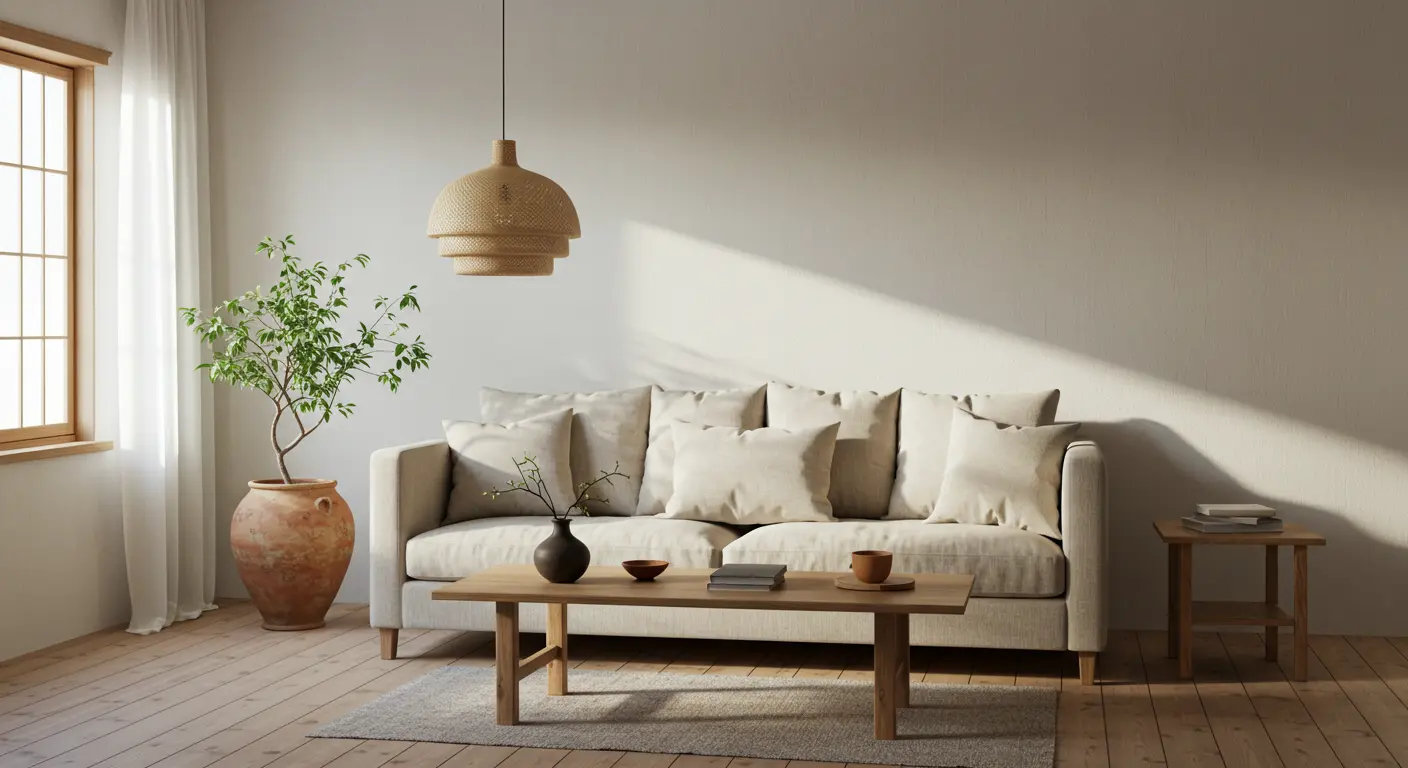
Have you ever imagined combining the coziness of Scandinavian design with the serenity of Japanese style? Japandi decor is exactly that harmonious fusion: an aesthetic that balances simplicity, functionality, and natural beauty. With clean lines, a neutral palette, and organic materials, this style creates environments that invite calm and contemplation.
In this article, you will discover how to apply Japandi in different spaces, even small ones, with practical tips and inspiration to transform your home into a true minimalist refuge, elegant and full of purpose.
What is Japandi decor?
The fusion between Scandinavian design and Japanese aesthetics
Minimalism, functionality, and warmth. These are the words that define the soul of Japandi decor, a style born from the union between Scandinavian design—originating in Nordic countries—and Japanese aesthetics, marked by the philosophy of the essential and the imperfect beauty of everyday life.
Despite being culturally distant, the two styles share fundamental principles: an appreciation for simplicity, the use of natural materials, the value of free space, and design that balances form and function. Their union results in environments that welcome the eye, calm the mind, and invite introspection.
While Scandinavian style offers visual coziness with light tones, wood, soft lighting, and an atmosphere of well-being, Japanese style contributes the concept of “wabi-sabi”—the beauty of the imperfect, the simple, and what is made to last. Japandi, therefore, is not an overlap of two styles, but a coherent fusion that gives rise to its own language: light, elegant, and deeply connected to the essential.
Philosophy of “less with purpose”
In Japandi, less isn’t just more—it’s better when every item has a reason to exist. It’s about a minimalism that goes beyond aesthetics and touches on how we inhabit and perceive the home: a place of physical and emotional rest, where everything has a purpose.
This philosophy translates into conscious choices: furniture with simple but well-designed lines; objects with a clear function or sentimental value; and a composition that breathes, without congested spaces or elements screaming for attention.
Unlike cold or impersonal minimalism, Japandi promotes visual warmth through natural textures, soft lighting, earthy colors, and materials like light wood, linen, ceramic, and bamboo. The goal is to create an environment that conveys tranquility, order, and functional beauty—like an invitation to slow down.
Adopting Japandi is also adopting a more intentional lifestyle. It’s looking inward before filling what’s outward. It’s understanding that a harmonious space begins with conscious choices that value time, nature, and simplicity as forms of well-being.
Key characteristics of the Japandi style
Neutral and natural color palette
One of the most striking elements of Japandi decor is the color palette—soft, welcoming, and deeply connected to nature. The style relies on neutral and earthy tones that convey serenity and visual flow.
Tones like:
- Beige, sand, off-white
- Light brown, caramel, tobacco
- Warm gray, charcoal
- Sage green, olive, or moss green
- Deep blue in small doses
This chromatic base allows environments to be both clean and welcoming. Color here is not used to grab attention, but to balance and harmonize, creating a sense of visual breathing room in every space.
The rule is clear: avoid strong contrasts or an excess of vibrant colors. In Japandi, the focus is on visual softness, which contributes to a calmer, more functional, and aesthetically balanced environment.
Materials used: light wood, ceramic, linen, bamboo
Japandi values nature in its most honest form, so the chosen materials are always natural, textured, and sustainably sourced. They add depth and warmth to the space without overwhelming it.
To further explore the role of textures in creating welcoming environments, also see the article Textures and Materials in Minimalist Design That Bring Visual Comfort, with practical suggestions for transforming spaces using only the essential.
Main materials that define the style:
- Light wood (e.g., freijó, oak, pine): brings warmth and structure
- Handmade ceramic: imperfect, with texture and personality
- Linen and raw cotton: light, breathable, and tactile fabrics
- Bamboo and rattan: oriental touches that integrate lightly
- Polished concrete and natural stone: used sparingly, balancing rusticity and elegance
These elements connect the environments to the organic world, creating a space that invites contemplation. Everything should seem simple, functional, and durable, with the charm of what is made to last.
The visual combination of these textures conveys warmth with lightness, as seen below:
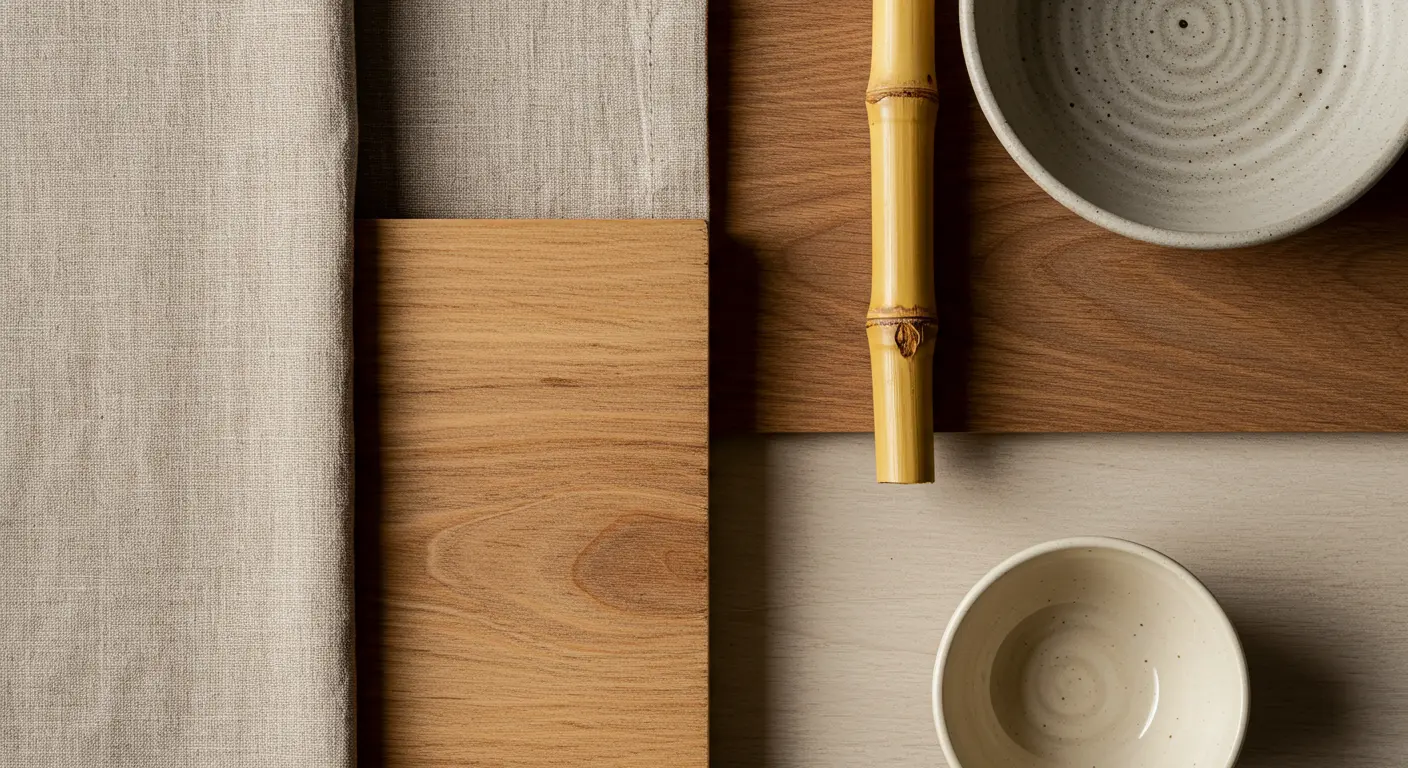
Furniture with simple lines and functionality
Furniture in the Japandi style follows the principle of less with purpose: they are low, well-structured, without unnecessary ornamentation. They prioritize comfort and practicality, but always with elegance.
Characteristics of Japandi furniture:
- Straight or slightly curved lines
- Low legs or close to the floor (Japanese influence)
- Light or dark wood with a matte finish
- Functional design, without excessive adornments
- Closed cabinets, clean tables, discreet shelves
The goal is to ensure fluid movement, spaciousness, and a sense of order—creating environments that work for those who live in them, not just to impress visually.
Connection with nature and visual silence
In the Japandi style, the home is a sanctuary. Therefore, the space needs to dialogue with nature and allow for moments of pause, silence, and contemplation.
How this translates in practice:
- Presence of green plants in simple, well-placed pots
- Environments with good natural light entry
- Use of materials that bring the outdoors in (wood, stone, ceramic)
- Avoid overly busy walls and surfaces
- Leave empty spaces as a way to respect the void
This “visual silence” is an essential part of the Japandi experience: a home that doesn’t overstimulate, but welcomes, balances, and inspires.
How to apply the Japandi style in different environments
Living room with welcoming simplicity
The living room is the heart of the home—and in the Japandi style, it transforms into a space for visual rest and reconnection. The secret lies in clearing the excess and valuing the essential: simple shapes, few objects, and well-placed natural materials.
How to compose:
- Straight-lined sofa in raw fabric or linen
- Coffee table in light wood with a matte finish
- Cotton or sisal rug in neutral tones
- Green plants in clay or handmade ceramic pots
- Indirect lighting with lampshades made of paper or fabric
Avoid cluttered shelves and opt for open niches or cabinets with smooth doors. One or two meaningful objects on display are enough to bring identity without compromising lightness.
Kitchen with a light and organized flow
The Japandi kitchen is designed to function fluidly. It’s a space where meal preparation becomes a quiet, almost meditative ritual. Everything is in its right place, without visual distractions or excessive utensils on display.
Key elements:
- Minimalist cabinets with integrated handles
- Countertops in natural stone, wood, or polished concrete
- Discreet shelves displaying handmade ceramics
- Neutral palette: white, sand, wood, and warm gray
- Details in bamboo or dark iron, in small quantities
The secret lies in the harmony between practicality and quiet aesthetics, inviting pause and respecting the time of making.
Bedroom with an atmosphere of deep rest
If there’s one place where the Japandi style shines, it’s the bedroom. Here, the focus is on creating an atmosphere that welcomes, calms, and prepares the body for rest. The aesthetic is clean, tactile, and deeply sensory.
Practical tips:
- Low bed, with a frame in light or dark wood
- Bedding in linen or cotton in soft tones
- Light curtains that filter natural light
- Warm, indirect lighting (sconces or fabric pendants)
- A simple rug beside the bed and a plant in the corner
Avoid flashy artwork, excessive decorative objects, or heavy furniture. Instead, create an environment with serene presence and emotional lightness—ideal for restoring body and mind.
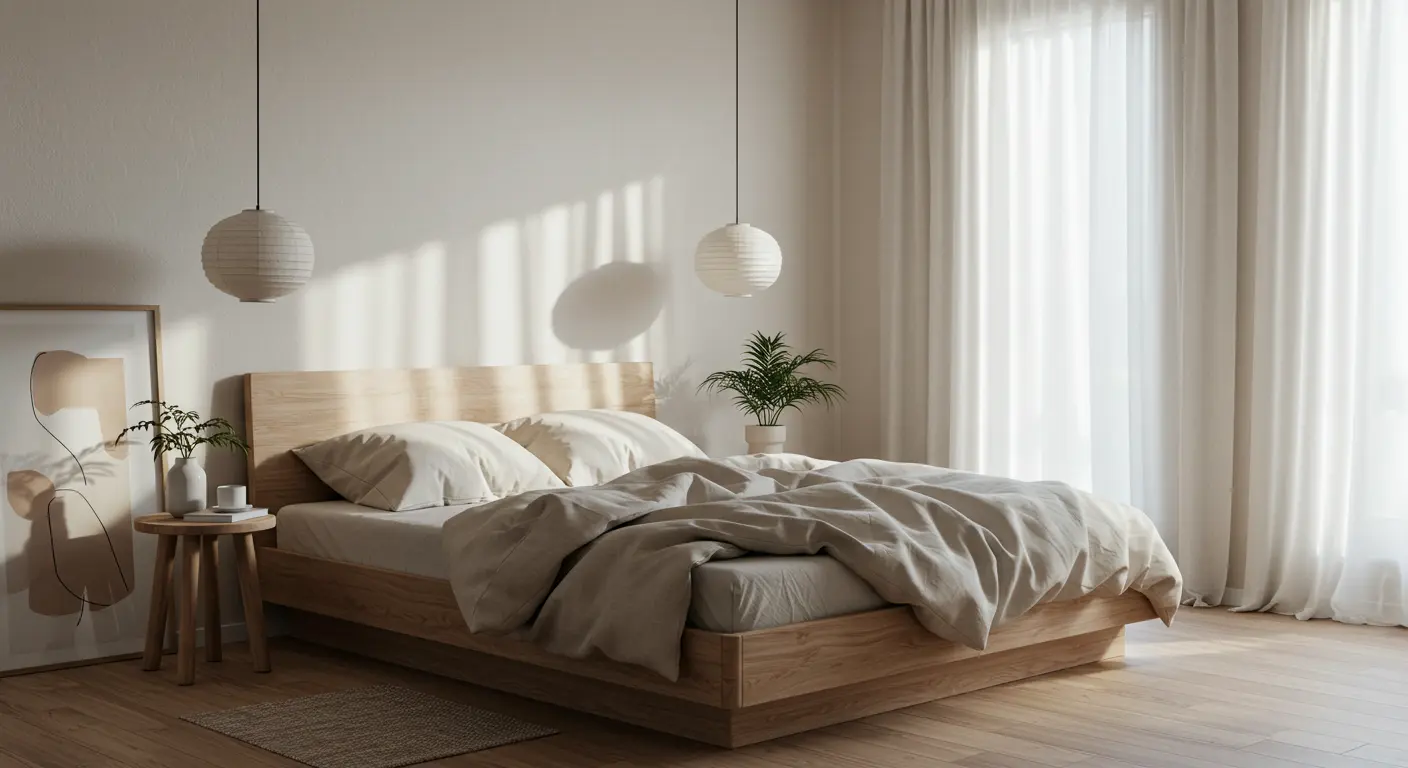
The Japandi style is especially effective in small environments, as it values free space, functional furniture, and fluid circulation. Each room becomes an extension of self-care.
Differences and similarities between Scandinavian and Japanese minimalism
Nordic warmth × Oriental serenity
Although stemming from different philosophies, Scandinavian and Japanese styles share essential values: simplicity, functionality, and appreciation for natural materials. However, each expresses this in its own way.
Scandinavian design prioritizes visual warmth. In regions with cold climates and little natural light, decor focuses on creating bright, comfortable, and warm spaces. Therefore, there is a strong presence of light wood, soft fabrics, and diffused lighting—elements that warm the environment and make it inviting.
Meanwhile, Japanese style values aesthetic silence, lightness, and the spirituality of the environment. Inspired by the wabi-sabi philosophy, it celebrates the beauty of imperfection, of what is natural, simple, and impermanent. The aesthetic is sober, restrained, and deeply contemplative.
In Japandi, these two worlds balance: the warmth of Scandinavia meets the serenity of Japan, creating a style that embraces the home as a space of presence, rest, and well-being.
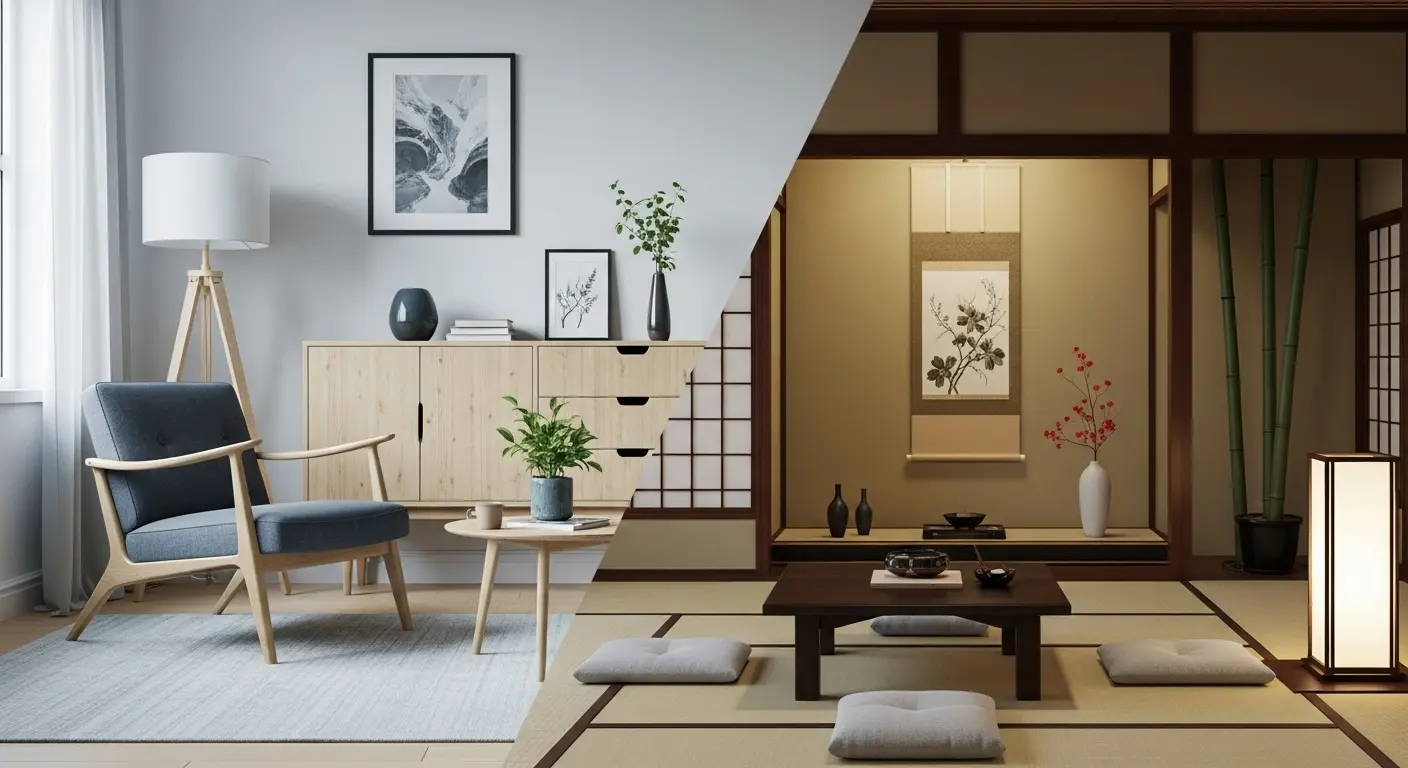
Textures and sensations
Another point of convergence (and subtle contrast) lies in how textures are used to convey sensations.
Scandinavian style relies on visual and tactile warmth with fabrics like wool, faux fur, and knitwear—elements that create cozy visual layers, especially in cold climates.
Japanese style, on the other hand, connects with nature through drier textures and clean visuals, such as bamboo, rice paper, aged wood, and raw ceramic. Beauty lies in imperfection and the use of empty space as an active component of the environment.
Japandi decor combines these approaches: it maintains lightness and neutrality but adds a soft contrast between smooth and organic, linen and concrete, rough and soft. Everything is carefully balanced to offer comfort without noise.
The perfect union between functionality and contemplation
If there’s one thing that completely unites the two styles, it’s the appreciation for functionality with discreet beauty. Nothing is superfluous; everything has a reason for being there—whether for its practical function or symbolic value.
Scandinavian style applies this logic with intelligent design and practical solutions for everyday life. Japanese style does so with a contemplative gaze and respect for impermanence. In Japandi, furniture is discreet, objects have a silent presence, and the space as a whole invites being—not accumulating.
This balance between functionality and contemplation is what makes Japandi decor more than just a style: it’s a philosophy of living with calm, intention, and essential beauty.
Common mistakes when trying to apply Japandi—and how to avoid them
Exaggerating the decor
One of the most frequent mistakes when trying to apply the Japandi style is wanting to mix “the best of both worlds” and ending up with excess. By combining Scandinavian and Japanese styles, many people are tempted to include too much furniture, overload textures, or scatter “zen” objects throughout the environment without criteria.
How to avoid it:
- Less is always more. Before adding a piece, ask: “Is it really necessary?”
- Give space for each object to breathe and take center stage.
- Prioritize a neutral palette and a few pieces of good quality, well-placed furniture.
The essence of Japandi lies in clarity and intention, not in the sum of visual styles.
Using excessive colors or patterns
Although visually welcoming, the Japandi style is not vibrant. Very intense colors, exaggerated contrasts, or striking patterns end up breaking the visual harmony the style proposes. The same applies to the indiscriminate mixing of patterns, textures, or overly decorative pieces.
If you want to delve deeper into applying neutral and earthy tones in your space, the article Minimalism and Colors: How to Use Colors to Create Minimalist and Cozy Environments offers valuable insights on balancing light, texture, and color with lightness.
How to avoid it:
- Keep the color palette within neutral and natural tones: beiges, soft grays, off-whites, earthy browns.
- If you want to add color, opt for desaturated tones, such as olive green or deep blue, used sparingly.
- Avoid large or colorful patterns. Prefer discreet patterns, inspired by organic or geometric shapes.
Remember: in Japandi, color serves to calm the eye—not stimulate it.
Losing the minimalist and natural essence
It’s easy to be charmed by beautiful furniture, handmade objects, and decorative pieces and end up forgetting the foundation of it all: functional simplicity and connection with nature. A visually beautiful environment might look Japandi at first glance, but if it doesn’t convey calm, fluidity, and honesty in materials, something is out of sync.
How to avoid it:
- Prioritize natural and honest materials, such as wood, ceramic, linen, stone, and bamboo.
- Avoid synthetic elements, varnished items, shiny plastics, or furniture with heavy finishes.
- Respect empty space—it’s as important as the objects present.
- Seek balance between form and function: a Japandi environment needs to be livable, not just aesthetic.
By keeping the focus on naturalness, sensory comfort, and functionality, your space will be much closer to the true spirit of Japandi.
Japandi as a lifestyle
Conscious consumption
More than an aesthetic trend, Japandi is a philosophy of living with less, but better. It invites slowing down the pace of consumption, rethinking what is truly necessary, and investing in pieces that are useful, durable, and made with integrity.
Instead of disposable, comes the handmade, the local, the sustainable. Quality furniture, objects with history, and materials that respect time and the environment. Conscious consumption in Japandi is not about restriction, but about intentional curation—knowing what deserves to be in your space.
The connection with nature can also be reinforced with simple and true choices. See how in the article How to Create a Minimalist Environment with Natural Elements, which brings practical ideas for applying organic materials authentically in everyday life.
Practical tip: before buying something new, ask yourself: will this add value or just fill space? If it doesn’t bring function, beauty, or meaning, perhaps it’s best to leave the space free.
Balance between beauty, well-being, and practicality
A Japandi environment needs to be beautiful, yes—but also comfortable and functional. The focus is on well-being: furniture that embraces the body, lighting that relaxes the eyes, textures that invite touch.
The style teaches us that beauty lies in simplicity, in a composition that requires no effort but brings tranquility on its own. Unlike purely decorative aesthetics, Japandi values daily use and the experience of being present.
Example: a well-designed chair in light wood that supports posture and matches the table; a light linen blanket that warms but also beautifies; a lamp with warm light that invites pause.
Everything in the environment has a purpose—and that purpose revolves around who lives there.
The environment as an extension of the inner state
In the Japandi style, the home ceases to be just a place of passage and transforms into an extension of your inner world. It is a space of welcome, reflection, and presence. Every room, every object, every void carries intention.
This more sensitive look at the home invites self-awareness: how do you want to feel here? What does your environment say about what you value? The Japandi style proposes that decor be not only functional but also a way of taking care of oneself, cultivating silence, and honoring simplicity.
The serenity of the environment can directly influence the rhythm of your days. Therefore, by adopting Japandi as a lifestyle, you are choosing to embrace the essential, both inside and outside yourself.
A visual example of this balance between interior and exterior is in this Japandi-inspired corner:
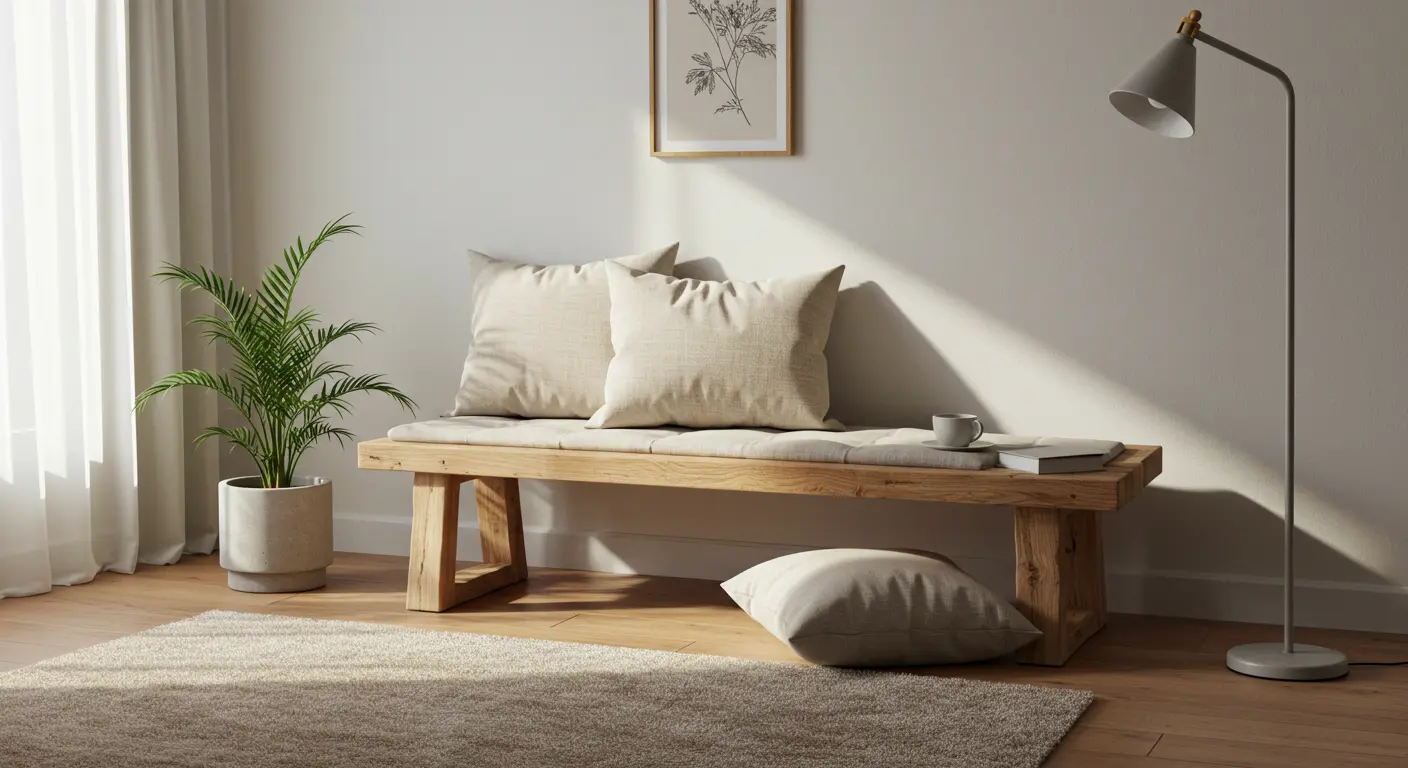
Visual Checklist: Does your space follow the principles of Japandi decor?
Use this list as a quick guide to assess whether your environment is in tune with the Japandi aesthetic and philosophy. Remember: it’s not about achieving perfection, but about making conscious choices that create harmony, well-being, and purpose in your home.
| Element | Is it present? ✅ | Personal observations |
|---|---|---|
| Neutral and natural color palette | Tones like beige, sand, warm gray, olive | |
| Furniture with simple lines and low legs | Functional, discreet, and comfortable | |
| Use of light wood and natural materials | Wood, ceramic, linen, bamboo | |
| Environments with free spaces and breathing room | Without excess, with fluid circulation | |
| Objects with functional or sentimental value | Few, well-chosen, with purpose | |
| Soft lighting and valued natural light | Warm, diffused light, presence of the natural | |
| Tactile and comfortable textures | Linen, raw cotton, jute, handmade ceramic | |
| Plants as a connection to the outdoors | Well-positioned, in simple pots |
Tip: check calmly, analyze your environment with an eye for simplicity and intention. Japandi doesn’t demand haste—it builds over time, like a gesture of care for what truly matters.
Conclusion: Live the harmony of Japandi with simplicity and intention
Japandi decor goes beyond an elegant aesthetic—it proposes a way of living that values silence, well-being, and the beauty of the essential. By uniting the lightness of Scandinavian design with Japanese serenity, Japandi transforms the home into a space of presence, balance, and functionality.
Adopting this style means choosing calm over excess, durability over disposability, and comfort that comes from simplicity. Every piece of furniture, every empty space, every texture is part of an environment designed to nurture—both inside and out.
Start small. Choose natural materials, value free space, opt for pieces that truly have meaning. Gradually, your home will cease to be just a place where you live—and will become the space that welcomes, inspires, and reflects who you truly are.
FAQ – Decoração Japandi
O que é o estilo Japandi?
Japandi é a fusão entre o design escandinavo e a estética japonesa. Une a funcionalidade, o aconchego e a simplicidade do estilo nórdico com a leveza, a naturalidade e o silêncio visual do estilo japonês. O resultado é uma decoração minimalista, serena e acolhedora, baseada em cores neutras, materiais naturais e propósito em cada escolha.
Como aplicar a decoração Japandi em apartamentos pequenos?
O Japandi é ideal para espaços reduzidos, pois valoriza a fluidez, o respiro visual e o uso inteligente dos móveis. Priorize peças multifuncionais, cores claras, poucos objetos e materiais naturais. Invista em iluminação suave, texturas leves e elementos que tragam sensação de calma sem ocupar muito espaço.
Qual a diferença entre o minimalismo japonês e o escandinavo?
O minimalismo escandinavo é mais voltado para o conforto e o aconchego visual, usando madeira clara, iluminação quente e tecidos macios. Já o minimalismo japonês valoriza a simplicidade silenciosa, o vazio, a imperfeição e a contemplação. O estilo Japandi combina o melhor dos dois: aconchego com intenção e leveza com profundidade.
Quais cores usar na decoração Japandi?
Use uma paleta neutra e terrosa. Os tons mais comuns incluem branco off-white, bege, areia, cinza quente, marrom claro, verde oliva e azul profundo. As cores devem criar um ambiente calmo e harmonioso. Evite cores vibrantes ou contrastes fortes, pois o objetivo é manter a suavidade visual.
Japandi combina com plantas?
Sim, e muito! As plantas são parte essencial da decoração Japandi, pois reforçam a conexão com a natureza e o bem-estar no ambiente. Prefira espécies simples, de fácil manutenção, em vasos neutros de barro, cerâmica ou cimento. Uma única planta bem posicionada já faz toda a diferença.
É possível usar o Japandi em ambientes com crianças?
Sim! O estilo Japandi funciona bem em lares com crianças porque prioriza a organização, a simplicidade e a funcionalidade. Basta adaptar o mobiliário à rotina da família, evitar peças frágeis ao alcance e manter o espaço leve, mas seguro. Com equilíbrio, é possível conciliar estética e praticidade no dia a dia.
Quais materiais são mais usados nesse estilo?
O Japandi valoriza materiais naturais como madeira clara, bambu, linho, algodão cru, cerâmica artesanal, pedra e rattan. Eles criam uma atmosfera orgânica, tátil e acolhedora. Prefira acabamentos foscos e texturas leves, evitando materiais sintéticos ou com brilho excessivo.
